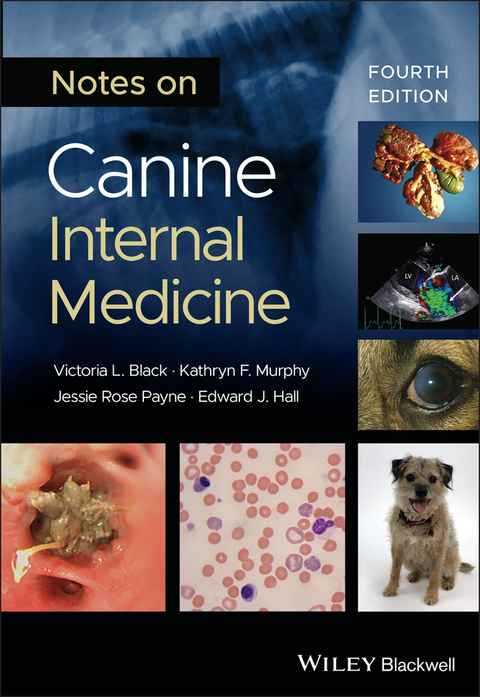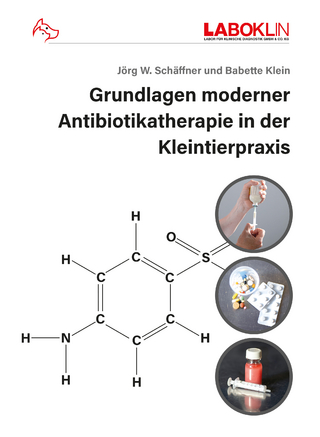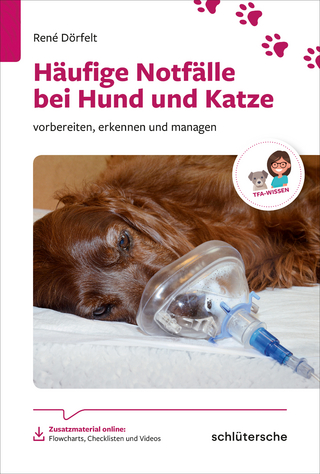
Notes on Canine Internal Medicine
Wiley-Blackwell (Verlag)
978-1-119-74477-1 (ISBN)
The newly revised Fourth Edition of »Notes on Canine Internal Medicine« delivers a comprehensive guide to the diagnosis of common and uncommon medical conditions in dogs.
Written to act as a practical and fast-access subject reference for veterinary practitioners and students, »Notes on Canine Internal Medicine« encourages physicians to take a logical and evidence-based approach to canine medicine. Divided into five sections, the first four are dedicated to clinical presentations, physical and laboratory abnormalities, and - new to this edition - imaging patterns. It concludes with a section on the organ systems of canines, providing a robust summary of how to diagnose and manage common specific conditions of each system.
This new edition includes:
- A thorough introduction to the clinical presentations of a variety of presenting complaints, with both common and uncommon causes of each complaint and a logical diagnostic approach
- In-depth examinations of common and uncommon physical problems, with a complete diagnostic approach including lab results and key imaging findings that aid in diagnosis
- Comprehensive explorations of laboratory abnormalities in haematology, serum biochemistry, and urinalysis
- Practical discussions of diagnostic imaging patterns, including plain radiographic, ultrasonographic, contrast radiographic, and cross-sectional imaging
»Notes on Canine Internal Medicine«, Fourth Edition is designed to be a useful resource for all veterinary clinicians; as a handy point of reference for veterinary students, recently graduated veterinary surgeons and those returning to work after career breaks, but also for experienced veterinary surgeons dealing with particularly difficult or challenging cases.
Victoria L. Black is an RCVS and European Specialist in Small Animal Internal Medicine at Langford Vets, Bristol Veterinary School, Bristol, UK.
Kathryn F. Murphy is a Fellow of the RCVS and an RCVS and European Specialist in Small Animal Internal Medicine at Rowe Referrals, Bristol, UK.
Jessie Rose Payne is an RCVS and ACVIM Specialist in Veterinary Cardiology at Langford Vets, Bristol Veterinary School, Bristol, UK.
Edward J. Hall is a Fellow of the RCVS, an RCVS and European Specialist in Small Animal Internal Medicine, and Emeritus Professor of Small Animal Internal Medicine at the University of Bristol, Bristol, UK.
Preface
Acknowledgements
Using this book
Commonly used abbreviations
SECTION 1 - Presenting Complaints
1.1 Abortion
1.2 Alopecia
1.3 Altered behaviour
1.4 Altered consciousness
1.5 Anorexia/hyporexia/inappetence
1.6 Anosmia
1.7 Anuria/oliguria
1.8 Ataxia
1.9 Bleeding
1.10 Blindness
1.11 Constipation
1.12 Corneal opacity
1.13 Coughing
1.14 Deafness
1.15 Diarrhoea
1.15.1 Acute diarrhoea
1.15.2 Chronic diarrhoea
1.16 Drooling
1.17 Dysphagia
1.18 Dyspnoea/tachypnoea
1.19 Dysuria
1.20 Dystocia
1.21 Epistaxis
1.22 Exercise intolerance
1.23 Faecal incontinence
1.24 Flatulence/borborygmi
1.25 Haematemesis
1.26 Haematochezia
1.27 Haematuria and discoloured urine
1.28 Haemoptysis
1.29 Halitosis
1.30 Head tilt
1.31 Melaena
1.32 Nasal discharge
1.33 Nystagmus
1.34 Paresis/paralysis
1.35 Perinatal death
1.36 Polyphagia
1.37 Polyuria/polydipsia (PU/PD)
1.38 Preputial discharge
1.39 Pruritus
1.40 Red eye (and pink eye)
1.41 Regurgitation
1.42 Seizures
1.43 Sneezing
1.44 Stiffness, joint swelling and generalised lameness
1.45 Stunting
1.46 Tenesmus and dyschezia
1.47 Tremors
1.48 Urinary incontinence
1.49 Vomiting
1.50 Vulval discharge
1.51 Weakness, collapse and syncope
1.52 Weight gain/obesity
1.53 Weight loss
SECTION 2 - Physical Abnormalities
2.1 Abdominal enlargement
2.2 Abdominal masses
2.3 Abnormal lung sounds
2.4 Arrhythmias
2.5 Ascites
2.6 Cyanosis
2.7 Eye lesions
2.8 Hepatomegaly
2.9 Horner's syndrome
2.10 Hypertension
2.11 Hypotension
2.12 Hypothermia
2.13 Icterus/jaundice
2.14 Lymphadenopathy
2.15 Murmur
2.16 Oral masses
2.17 Pain
2.17.1 Abdominal pain
2.17.2 Generalised pain
2.18 Pallor
2.19 Perineal lesions
2.20 Peripheral oedema
2.21 Pleural effusion
2.22 Pneumothorax
2.23 Prostatomegaly
2.24 Pulse abnormalities
2.25 Pyrexia and hyperthermia
2.26 Skin lesions
2.27 Skin pigmentation changes
2.28 Splenomegaly
2.29 Stomatitis
2.30 Stridor and stertor
SECTION 3- Laboratory Abnormalities
3A Biochemical tests
3.1 Acid-base
3.2 Ammonia
3.3 Amylase and lipase
3.4 Azotaemia
3.5 Bile acids
3.6 Bilirubin
3.7 Calcium
3.7.1 Hypercalcaemia
3.7.2 Hypocalcaemia
3.8 Cardiac biomarkers
3.8.1 N-terminal pro B-type natriuretic peptide (NT-proBNP)
3.8.2 Troponin I
3.9 Chloride
3.9.1 Hyperchloraemia
3.9.2 Hypochloraemia
3.10 Cobalamin
3.11 Cortisol (basal)
3.12 Creatine kinase
3.13 Creatinine
3.14 C-reactive protein
3.15 Folate
3.16 Fructosamine
3.17 Glucose
3.17.1 Hyperglycaemia
3.17.2 Hypoglycaemia
3.18 Iron profile
3.19 Lipids
3.19.1 Hyperlipidaemia and hypercholesterolaemia
3.19.2 Hypocholesterolaemia
3.20 Liver enzymes
3.20.1 Hepatocellular marker enzymes
3.20.1A Alanine aminotransferase (ALT)
3.20.1B Aspartate aminotransferase (AST)
3.20.1C Other hepatocellular enzymes
3.20.2 Cholestatic marker enzymes
3.20.2A Alkalane phosphatase (ALP or ALKP)
3.20.2B Gamma-glutamyl transferase (GGT)
3.21 Pancreatic lipase (cPL)
3.22 Phosphate
3.22.1 Hyperphosphataemia
3.22.2 Hypophosphataemia
3.23 Potassium
3.23.1 Hyperkalaemia
3.23.2 Hypokalaemia
3.24 Sodium
3.24.1 Hypernatraemia
3.24.2 Hyponatraemia
3.25 Symmetric dimethylarginine (SDMA)
3.26 Thyroid hormone
3.27 Total protein (albumin and globulin)
3.27.1 Hyperproteinaemia
3.27.1A Hyperalbuminaemia
3.27.1B Hyperglobulinaemia
3.27.2 Hypoproteinaemia
3.27.2A Hypoalbuminaemia
3.27.2B Hypoglobulinaemia
3.28 Trypsin-like immunoreactivity (TLI)
3.29 Urea
3B Haematology
3.30 Red blood cells (RBCs)
3.30.1 Anaemia
3.30.2 Erythrocytosis
3.31 Platelets
3.31.1 Thrombocytopenia
3.31.2 Thrombocytosis
3.32 White blood cells (WBCs)
3.32.1 Leukocytosis
3.32.2 Leukopenia
3.33 Pancytopenia
3C Urinalysis
3.34 Biochemical analysis
3.34.1 Protein
3.34.2 Bilirubin
3.34.3 Glucose
3.34.4 Haem
3.34.5 Ketones
3.35 Sediment
3.35.1 Red blood cells
3.35.2 White blood cells
3.35.3 Epithelial cells
3.35.4 Crystals
3.35.5 Tubular cast
3.35.6 Waxy cast
3.36 Urine protein:creatinine (UPC) ratio
3.37 Urine specific gravity (USG)
SECTION 4 - Imaging Patterns
4.1 Abdomen
4.1.1 Radiography
4.1.1A Abdominal enlargement and mass(es)
4.1.1B Calcification (bone/mineral density)
4.1.1C Extra-intestinal gas
4.1.1D Gas dilation of GI tract
4.1.1E Loss of contrast/peritoneal detail/serosal detail
4.1.1F Metal densities
4.1.1G Organ displacement
4.1.1H Organomegaly or change in shape
4.1.2 Ultrasound
4.1.2A Free abdominal fluid
4.1.2B Lymphadenopathy - mesenteric/inguinal/sublumbar
4.2 Bone
4.2.1 Bone deformities
4.2.2 Bone density changes
4.2.2A Decreased bone density (osteopenia)
4.2.2B Increased bone density
4.2.3 Bone lucencies and proliferative lesions
4.3 Thorax
4.3.1 Alveolar pattern
4.3.2 Bronchial pattern
4.3.3 Changes in cardiac outline and pulmonary vasculature
4.3.4 Interstitial pattern
4.3.5 Loss of detail
SECTION 5 -Organ Systems
5.1 Alimentary system
5.1.1 Oropharynx
5.1.1A Craniomandibular osteopathy
5.1.1B Cricopharyngeal achalasia
5.1.1C Masticatory myositis
5.1.1D Oral neoplasia
5.1.1E Stomatitis
5.1.2 Salivary glands
5.1.2A Hypersialosis/salivary gland infarction/sialoadenitis
5.1.3 Oesophagus
5.1.3A Foreign body
5.1.3B Megaoesophagus (MO)
5.1.3C Oesophagitis
5.1.3D Sliding hiatal hernia
5.1.3E Oesophageal stricture
5.1.4 Stomach
5.1.4A Acute gastritis
5.1.4B Chronic gastritis
5.1.4C Gastric carcinoma
5.1.4D Gastric dilatation-volvulus (GDV)
5.1.4E Delayed gastric emptying
5.1.4F Gastric ulcer
5.1.5 Small intestine
5.1.5.1 Acute small intestinal diseases
5.1.5.1A Acute enteritis
5.1.5.1B Acute haemorrhagic diarrhoea syndrome (AHDS)/haemorrhagic gastroenteritis (HGE)
5.1.5.1C Bacterial enteritis
5.1.5.1D Parvovirus
5.1.5.1E Small intestinal obstruction
5.1.5.2 Chronic small intestinal diseases
5.1.5.2A Alimentary lymphoma (AL)
5.1.5.2B Antibiotic-responsive diarrhoea (ARD)
5.1.5.2C Chronic inflammatory enteropathy (CIE)
5.1.5.2D Dietary sensitivity
5.1.5.2E Intestinal parasitism
5.1.5.2F Intestinal protozoal infections
5.1.5.2G Lymphangiectasia
5.1.6 Large intestine
5.1.6A Acute colitis
5.1.6B Chronic colitis
5.1.6C Constipation
5.1.6D Granulomatous (histiocytic ulcerative) colitis
5.1.6E Large intestinal neoplasia
5.1.7 Pancreas
5.1.7A Acute pancreatitis
5.1.7B Chronic pancreatitis
5.1.7C Exocrine pancreatic insufficiency (EPI)
5.2 Cardiovascular system
5.2.1 Acquired cardiac diseases
5.2.1A Arrhythmogenic right ventricular cardiomyopathy (ARVC)
5.2.1B Dilated cardiomyopathy (DCM)
5.2.1C Heartworm disease/dirofilariasis
5.2.1D Myxomatous mitral valve disease
5.2.2 Congenital cardiac diseases
5.2.2A Aortic stenosis
5.2.2B Mitral valve dysplasia
5.2.2C Patent ductus arteriosus
5.2.2D Pulmonic stenosis
5.2.2E Tetralogy of Fallot
5.2.2F Tricuspid dysplasia
5.2.2G Ventricular septal defect
5.2.3 Congestive heart failure
5.2.3A Left-sided congestive heart failure
5.2.3B Right-sided congestive heart failure
5.2.4 Arrhythymias]
5.2.4.1 Bradyarrhythmias
5.2.4.1A Atrial standstill
5.2.4.1B Atrioventricular (AV) block
5.2.4.1C Sinus bradycardia
5.2.4.1D Sinus arrest
5.2.4.1E Sick sinus syndrome
5.2.4.2 Tachyarrhythmias
5.2.4.2A Sinus tachycardia
5.2.4.2B Supraventricular tachyarrhythmias
5.2.4.2C Ventricular tachyarrhythmias
5.2.5 Pericardial disease
5.2.5.A Pericardial effusion
5.2.5.B Peritoneal pericardial diaphragmatic hernia (PPDH)
5.3 Endocrine system
5.3.1 Diabetes insipidus (DI)
5.3.2 Diabetes mellitus (DM)
5.3.3 Growth hormone disorders
5.3.3A Acromegaly (hypersomatotropism)
5.3.3B Pituitary dwarfism
5.3.4 Adrenal gland disorders
5.3.4A Hyperadrenocorticism (HAC)
5.3.4B Hypoadrenocorticism (Addison's disease)
5.3.5 Hypothyroidism
5.3.6 Insulinoma
5.3.7 Parathyroid diseases
5.3.7A Primary hyperparathyroidism (PHPT)
5.3.7B Hypoparathyroidism
5.4 Haemopoietic system
5.4.1 Anaemia of chronic kidney disease (CKD)
5.4.2 Immune-mediated haemolytic anaemia (IMHA)
5.4.3 Iron-deficiency anaemia
5.4.4 Lymphoid leukaemia
5.4.5 Other haemopoietic neoplasms
5.4.6 Leukopenia
5.4.7 Thrombosis
5.5 Haemostatic system
5.5.1 Anticoagulant rodenticide poisoning
5.5.2 Disseminated intravascular coagulation (DIC)
5.5.3 Factor VIII deficiency (haemophilia A)
5.5.4 Hyperfibrinolysis
5.5.5 Immune-mediated thrombocytopenia (IMTP)
5.5.6 von Willebrand disease
5.5.7 Vasculitis
5.6 Hepatobiliary system
5.6.1 Chronic hepatitis (CH)/cirrhosis
5.6.2 Cholangitis/cholangiohepatitis
5.6.3 Cholecystitis
5.6.4 Congenital porto-systemic shunt (PSS)
5.6.5 Copper-associated chronic hepatitis
5.6.6 Extra-hepatic bile duct obstruction (EHBDO)
5.6.7 Gall bladder mucocoele
5.6.8 Hepatic neoplasia
5.6.9 Infectious canine hepatitis
5.6.10 Nodular hyperplasia
5.6.11 Portal vein hypoplasia (PVH)
5.6.11A Microvascular dysplasia
5.6.11B Non-cirrhotic portal hypertension/juvenile hepatic fibrosis
5.6.12 Steroid hepatopathy
5.6.13 Vacuolar/reactive hepatopathy
5.7 Immune system
5.7.1 (Auto)immune-mediated disorders
5.7.1A Immune-mediated polyarthritis (IMPA)
5.7.1B Immunodeficiency
5.7.1C Lymphadenitis
5.7.1D Systemic lupus erthythematosus (SLE)
5.7.2 Neoplasia of immune cells
5.7.2A Lymphoma
5.7.2B Mast cell tumour (MCT)
5.7.2C Multiple myeloma
5.7.2D Thymoma
5.8 Neurological system
5.8.1 Cerebrovascular disease
5.8.2 Corticosteroid-responsive tremor syndrome
5.8.3 Hydrocephalus
5.8.4 Idiopathic epilepsy
5.8.5 Idiopathic head tremor
5.8.6 Idiopathic vestibular disease
5.8.7 Infectious diseases affecting the nervous system
5.8.8 Movement disorders
5.8.9 Meningoencephalitis of unknown origin (MUO)
5.8.10 Myasthenia gravis (MG)
5.8.11 Neoplasia of the neurological system
5.8.12 Polyradiculoneuritis
5.8.13 Steroid-responsive meningitis-arteritis (SRMA)
5.9 Reproductive system
5.9.1 Mammary gland diseases
5.9.1A Mastitis
5.9.1B Mammary neoplasia
5.9.2 Ovarian remnant syndrome
5.9.3 Prostatic disease
5.9.4 Pseudocyesis
5.9.5 Pyometra
5.9.6 Testicular neoplasia
5.9.7 Vaginitis
5.10 Respiratory system
5.10.1 Nasal disorders
5.10.1A Chronic idiopathic rhinitis
5.10.1B Sinonasal aspergillosis (fungal rhinitis)
5.10.2 Upper-airway disorders
5.10.2A Brachycephalic obstructive airway syndrome (BOAS)
5.10.2B Infectious tracheobronchitis
5.10.2C Laryngeal paralysis
5.10.2D Tracheal collapse
5.10.2E Tracheobronchial foreign body
5.10.3 Lower-airway disorders
5.10.3A Chronic bronchitis
5.10.3B Eosinophilic bronchopneumopathy
5.10.3C Lungworm (Angiostrongylus vasorum)
5.10.4 Pulmonary parenchymal disease
5.10.4A Pneumonia
5.10.4B Non-cardiogenic pulmonary oedema
5.10.4C Pulmonary fibrosis
5.10.4D Pulmonary neoplasia
5.10.5 Pleural space disease
5.10.5A Idiopathic chylothorax
5.10.5B Pneumothorax
5.10.5C Pyothorax
5.11 Systemic infections
5.11.1 Anaplasmosis
5.11.2 Babesiosis
5.11.3 Borreliosis (Lyme disease)
5.11.4 Brucellosis
5.11.5 Distemper
5.11.6 Ehrlichiosis
5.11.7 Hepatozoonosis
5.11.8 Leishmaniosis
5.11.9 Leptospirosis
5.11.10 Neosporosis
5.11.11 Rabies
5.11.12 Toxoplasmosis
5.12 Urinary system
5.12.1 Kidney diseases
5.12.1A Acute kidney injury
5.12.1B Chronic kidney disease
5.12.1C Glomerular disorders
5.12.1D Pyelonephritis
5.12.1E Renal tubular disorders
5.12.2 Lower urinary tract diseases
5.12.2A Functional disorders of urination
5.12.2B Neoplasia of the urinary system
5.12.2C Urethritis
5.12.2D Urinary tract infection (UTI)
5.12.2E Urolithiasis
Abbreviations
Index
| Erscheinungsdatum | 22.07.2022 |
|---|---|
| Verlagsort | Hoboken |
| Sprache | englisch |
| Maße | 170 x 244 mm |
| Gewicht | 1002 g |
| Einbandart | kartoniert |
| Themenwelt | Veterinärmedizin ► Kleintier ► Innere Medizin |
| Schlagworte | Hunde; Veterinärmedizin • Innere Medizin Kleintiere • Innere Medizin (Veterinärmedizin) |
| ISBN-10 | 1-119-74477-6 / 1119744776 |
| ISBN-13 | 978-1-119-74477-1 / 9781119744771 |
| Zustand | Neuware |
| Haben Sie eine Frage zum Produkt? |
aus dem Bereich



